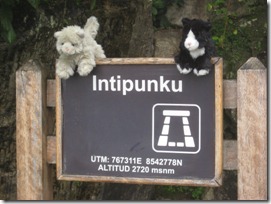After all the crazy things we’ve eaten in the past few months, we’re both really ready to get home and eat some “normal food”. Top of the craving list: apples and cheese, and easy access to Starbucks.
But we also have really enjoyed the great variety and quality of foods we’ve had a chance to taste around the world. Food can often be an important reflection of the places and cultures you visit and this trip has been no exception. Plus, it’s yummy. Well, sometimes yummy.
The foods we remember most:
- Antarctica: The chefs on the Orlova did quite an impressive job – and we’re still in wonder how we could still be eating quality produce up until the last day of our 19 days at sea. The chefs would do multi-course meals with at least three different main course options each day and even the most finicky eater could reliably find something they liked. The bartender served drinks with glacial ice (yes, really). But the pastry chef was probably the most out of control. Beautifully presented, delicious desserts were on hand after both lunch and dinner – and don’t forget the platefuls of dainties at teatime. I’m surprised the ship could stay afloat with all the weight gain of the passengers.
- Argentina: This place is famous for its steak of course, so we certainly had our share. But probably the best thing we had in Argentina (well, apart from the gelato of course 🙂 ) was the empanadas they served at our hotel in Ushuaia. If you ever find yourself in the southernmost city in the world, you’ve gotta stop by the Hotel Albatross and taste these… while you ponder how lucky you are to be in such a cool place.
- Peru: Before my mom asks, no we did not eat the guinea pigs Anthony Bordain talked about in Peru – but it was pretty easy to find, as was llama and alpaca. What we did eat was a LOT of lomito saltado – sautéed steak and veggies over rice. I’ve also eaten a lot of lomito saltado at the Copacabana restaurant at Pike Place Market in Seattle and I had been a bit worried whether the “real thing” would be as good. It was – and even thinking of it now is making me drool. If you aren’t able to make it to Peru anytime soon, you should hit the Copacabana so you know what I’m talking about. But if you’re looking for some coca tea to go with it, you’re gonna have to catch a flight – ‘cause it ain’t legal in the States.
- Ecuador: Quito = McDonald’s (sadly), so all we have to report is that the names of the food might be a little different but it’s otherwise same same. So, for Ecuador, really the only memorable food we had was in Galapagos and most of the good options were seafood. But what stands out the most for us was a restaurant called Red Mangrove Inn in Puerto Ayora that had good sushi and a chicken teriyaki that would blow your mind. Plus the place has a great view and vibe. Highly recommend it. You should also check out the soda they have in Ecuador – Fiori Vanti – tastes like a Shirley Temple. Yum.
- Brazil: Again, they like their steak here. And it’s good – though I do notice that both Brazilians and Argentineans tend to overcook their steaks to my personal liking. I’m more a medium rare kind of girl and everything I got there was very well done. But I love steak about as much as they do, so I was happy no matter how I got it. I also enjoyed plenty of caipirinhas and caipivodkas (vodka instead of cachaça) to wash it down. When in Brazil, I always say…
- Cambodia and Thailand: Both countries serve pretty similar food (although only in Cambodia did we see snake, kangaroo and crocodile on one menu). Great fresh fruit everywhere (also true in much of South America) has deepened my passion for mango along with crazy Asian fruits you don’t see anywhere else, like dragonfruit which has a very light but refreshing flavor and is the prettiest/most interesting looking fruit I’ve ever seen. As for the rest of the food, for awhile I was mixing things up between Phad Thais, cashew chickens, and curries of every color of the rainbow… but now I’ve settled into nearly a curry-only existence. And it’s a pretty happy existence I must say.
Cambodia:
- Thailand:
After all that variety, our stomachs are pretty much entirely confused. And, thanks to a steady three (plus) meal a day schedule, about ten pounds heavier. If just for that reason, it’ll be good to get back to Seattle…
So we can go back out and eat Thai and South American food there in the cold and rainy comfort of home. 🙂































































































